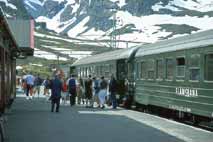


In 1923, work was started on the separate railway line from Myrdal down sheer cliffs to Flåm. Since the tunnels were done by hand, the first of the track wasn't put down until autumn 1936. By 1940, the line was opened and run by first by steam engines. Electric engines took over in 1944. It takes about an hour to cover 12 miles of track on the Flåmsbana train. Eighteen of the 20 tunnels were chiseled out by hand which took one month of hard labor for each meter excavated. To avoid risk from avalanches, the railway criss-crosses the river and the bottom of the valley three times. Then, instead of building bridges, the river was routed through a tunnel under the railway line. Nowhere else in the world do adhesion rail cars on normal tracks have a steeper journey. Almost 80% of the railway line has a gradient of 5.5% (1:18).
The major challenge for the railway engineers was in planning a safe
rail track that decends 2,838 feet in 12 miles. Careful planning
was necessary to traverse from the Myrdal plateau down the steep mountain
past Lake Reinunga which feeds the awesome Kjosfossen waterfall to the
bottom of the Flåm Valley. The twisting tunnel, which winds
its way inside the mountain at several levels, is one of the most unique
solutions designed by skilled Norwegian engineers. To snake the track safely
down the sheer inclines called for very unique solutions like spiraling
in and out of the mountains. The carriages are fitted with no less
than 5 different braking circuits, even though any one is enough to stop
the train, if necessary. And, the railway runs everyday of the year...rain,
snow, or whatever...delivering people, and the mail!

At the foot of the mountains, in Flåm (population 450) you can
see the beauty of Flåmsdalen (the valley) and the fjords: Aurlandsfjord,
a branch of the larger Sognefjord. The Sognefjord is one of Norway's
longest fjords extending 112 miles inland from the sea.
The Flåm Railway attracts people from all over the world. Much of the literature is translated in Japanese as well as in German, French, Spanish and English. It is one of the most spectacular attractions in Norway, and perhaps all of Europe.
<----This picture is one we took of the Flåm harbor area.
We stayed in Flåm overnight. Then, we boarded the fjord steamer which took us out the Aurlandsfjord
and back the narrower Nærøyfjord. The boat trip takes a leisurely
2 hours gliding past snow-capped mountains almost 6,000 feet high. Then, there is a comfortable (warm) bus that picks you up at the
boat dock at Gudvangen and winds back up the mountains to the train station
at Voss. From there you can catch a train either to Oslo or to Bergen.
As an alternative, you can do this Norway in a Nutshell Tour all in one
day and then take the night train back to Oslo. But, if you have
the time, I would recommend staying in Flåm.
News Flash: They just opened the Lærdalstunnelen (Lærdal Tunnel): the longest road tunnel in Europe. The new tunnel connecting Lærdal with the fjord towns of Aurland and Flam is 24,5 kilometres long. It was opened by HM King Harald of Norway on November 27, 2000. The tunnel was quite an engineering feat providing better access to the fjords from Oslo and is the final road connection to the coastal town of Bergen. The tunnel is open all year round providing better access into and through these areas especially in the winter. Since it opened after we left Norway, we didn't have the option of seeing the tunnel. Maybe, next time! For more information, try one of these links:
Lærdalstunnelen (in Norwegian)
Tunnel Information (in English and Norwegian)
Rick Steves, travel guru, says: "If you go to Oslo and don't get out to the
fjords, you should have your passport revoked." (Europe Through The
Back Door, p.382) And, he is right. It was definately a highlight
of our trip. His website is well worth visiting. It's a great
place to get a Eurail pass, if you plan to travel by train in Europe, plus lots
of other help, travel stories and other information.
© 2001 JKH